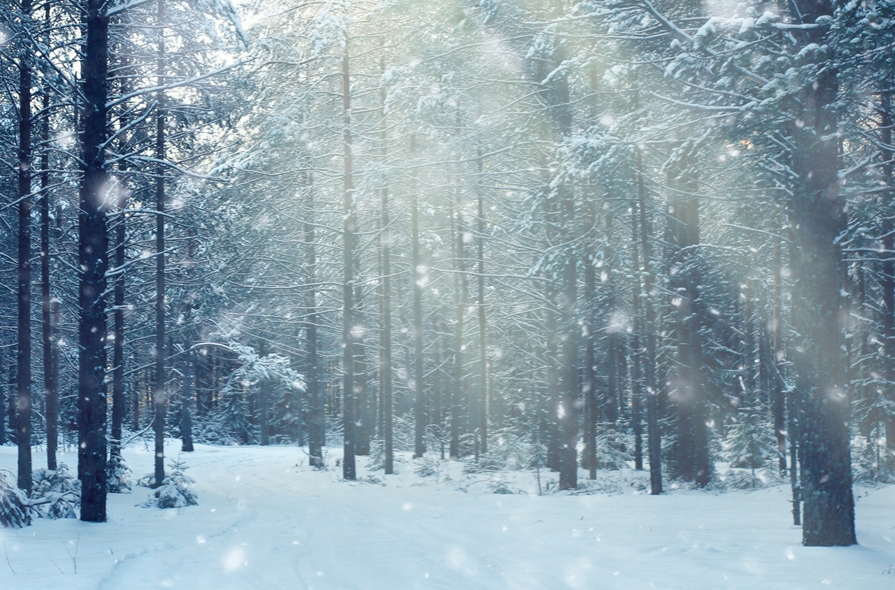The Effects of Winter on Our Sleep

The changing of the seasons can bring on some wonderful comforts like hot chocolate, movie marathons, and warm quilts. But the arrival of the coming winter solstice (the longest night of the year) also brings changes in daylight hours. It’s a big adjustment to those dark mornings and fewer total hours of sunlight. There’s a fair amount of research surrounding the effects of winter on our bodies and sleep health. In this article, we’ll dive into the changes you’ll experience over the winter months, how light affects your rest and your overall health, and some tips to getting restful sleep all winter long.
How Does Light Effect Sleep?
The balance of daylight and darkness following the winter solstice and spring equinox have a profound effect on sleep. Exposure to light early in the day stimulates your body and mind and encourages feelings of wakefulness, alertness, and energy. Artificial light exposure at night also stimulates alertness—and that can pose a serious problem to getting healthy, abundant, refreshing sleep. Too little sunlight during the day can lead to issues such as Seasonal Affective Disorder and hypersomnia. Too much exposure to artificial light during the evening can make it hard to fall asleep.
Darkness is another component essential for sleep. The absence of light sends a critical signal to the body that it is time to rest. Darkness and light exposure at the wrong times alter the body’s internal “sleep clock”—the biological mechanism that regulates sleep-wake cycles—in ways that interfere with both the quantity and quality of sleep. Melatonin, a hormone produced by your brain’s pineal gland, is often known as the “sleep hormone” or the “darkness hormone.” Melatonin influences sleep by sending a signal to your brain that it is time for rest. This signal helps initiate your body’s physiological preparations for sleep. Your muscles begin to relax, feelings of drowsiness increase and your body temperature starts to drop. Your melatonin levels naturally rise during the early evening as darkness falls and continue to climb throughout most of the night, before peaking at approximately 3 a.m. Levels of melatonin then fall during the early morning and remain low during much of the day.
Effects of Winter
During the winter, when sunlight hours are limited, approximately 14% of the population experiences the winter blues and 6% suffer from a more severe form known as Seasonal Affective Disorder (SAD). People suffering from SAD tend to have a hard time waking up in the morning, and experience lowered energy levels and increased appetite. SAD is also known to cause hypersomnia (excessive sleepiness), and sufferers report sleeping up to 2.5 hours more in the winter than in the summer. Although the extra sleep may sound like a good idea, if you are already getting the required 7-9 hours per night, it could be unhealthy. If you think you may be experiencing the winter blues, try getting some exercise while the sun is out or try light therapy with the Journi Mobile Task Light, which can help keep your sleep schedule consistent, allowing you to wake feeling great every day.
How is Light Measured?
All light is not created equal. Understanding how light is measured can help you manage your exposure to artificial light more thoughtfully. There are a couple of measurements that are important in the world of light and dark: lumen and lux. Lumen is a measurement of light intensity or brightness, also known as radiance, at the source of the light itself. As light moves from its source, it disperses and its intensity changes. So, when you’re thinking about your exposure to light, it’s not just the intensity of light itself that matters, it’s also your distance from the light. That’s where lux comes in. Lux takes lumen values and factors in the surface area over which light spreads. Lumen values can tell you how bright a light bulb is, but lux values can give an indication of how bright that light is in the space in which it—and you—reside.
Tips for Managing the Light
Managing your exposure to light in your home and bedroom is fundamental to creating a healthy sleep environment. With awareness and some simple planning, you can create a bedroom that guards against unwanted light at night and protects the quality of your sleep until you are ready to wake.
Once it’s lights out, an eye mask worn at night can help protect against intrusive light. Choose a mask that is soft, comfortable, and flexible. Wearing an eye mask can take a little getting used to, but it is a highly effective tool for limiting your light exposure at night. Curtains and shades on windows can also keep outside light from disturbing your sleep. Just make sure window coverings are heavy enough to fully block light and are well fitted to avoid slivers of street light or early morning sunlight from filtering in. Even brief exposure to light can interfere with sleep. Blackout curtains are designed to provide this kind of thorough protection against unwanted light.
If you need a source of light during the night—to make your way comfortably to the bathroom or to a child’s bedroom—use a nightlight with a red bulb. Red is a long wavelength light that has been shown to be less disruptive to sleep than other light wavelengths. Put the nightlight in a hallway or another room, if possible. Having a small night light in place will help you avoid having to flood your middle-of-night environment with unwanted, sleep-disrupting brightness.
Being aware of light’s effects on the body will help you pay more attention to the light that surrounds you, both day and night. Taking a little time to ensure a dark sleeping environment is one easy way to protect and improve your nightly rest, no matter what solstice is approaching.